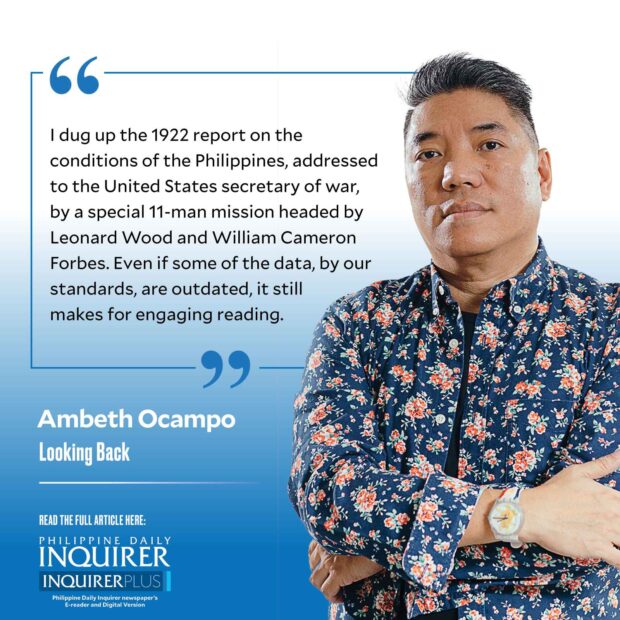Resisting historical change
 Despite repeated correction over the decades, some stubborn, ahistorical people cannot let go of “Maynilad” with a “d.” Promoting this mistake are the water concessionaire Maynilad and misguided folks in Manila City Hall. Like Quiapo, which got its name from “kiapo,” the green water plant Pistia stratiotes, Manila also got its name from a water plant known as “nila” (without a “d”). Manuel Blanco’s “Flora de Filipinas” (1837) has an image of “Ixora Manila Blanco” also known under the complicated scientific name Scyphiphora hydrophylacea.While browsing over pictures of “Old Manila” in my social media feed, I was reminded that long before Manila was eaten by today’s megacity, Metro Manila, or by the National Capital Region, the capital of Spanish Manila was limited to the area literally within (intra) the walls (muros) of Intramuros. Districts considered part of Manila today like Quiapo, Binondo, Santa Cruz, Ermita, Malate, etc. were suburbs (arrabales) outside the walls or Extra-muros de Manila. A wealth of archival photographs, documents, maps, etc. are simply traces on which we build an image of the land and people in the city honored by a 16th-century Spanish king with a coat of arms and the title “distinguished and ever loyal.”
Despite repeated correction over the decades, some stubborn, ahistorical people cannot let go of “Maynilad” with a “d.” Promoting this mistake are the water concessionaire Maynilad and misguided folks in Manila City Hall. Like Quiapo, which got its name from “kiapo,” the green water plant Pistia stratiotes, Manila also got its name from a water plant known as “nila” (without a “d”). Manuel Blanco’s “Flora de Filipinas” (1837) has an image of “Ixora Manila Blanco” also known under the complicated scientific name Scyphiphora hydrophylacea.While browsing over pictures of “Old Manila” in my social media feed, I was reminded that long before Manila was eaten by today’s megacity, Metro Manila, or by the National Capital Region, the capital of Spanish Manila was limited to the area literally within (intra) the walls (muros) of Intramuros. Districts considered part of Manila today like Quiapo, Binondo, Santa Cruz, Ermita, Malate, etc. were suburbs (arrabales) outside the walls or Extra-muros de Manila. A wealth of archival photographs, documents, maps, etc. are simply traces on which we build an image of the land and people in the city honored by a 16th-century Spanish king with a coat of arms and the title “distinguished and ever loyal.”
Not wanting to go far into pre-Spanish Manila for this column, I dug up the 1922 report on the conditions of the Philippines, addressed to the United States secretary of war, by a special 11-man mission headed by Leonard Wood and William Cameron Forbes. Even if some of the data, by our standards, are outdated, it still makes for engaging reading. For example, their count of the number of islands in the archipelago is “approximately 3,000” not the official count today of 7,640.
The report contrasted the total population based on the 1903 Census (7,635,426) with the 1921 headcount (10,956,000), breaking it down according to religion (Christian, Mohammedan, Pagan, and Buddhist) and “foreigners” (Americans, Spanish, British, Chinese, Japanese, and “all others” whatever that means). The total wealth of the islands was estimated at $5,500,000,000, comparatively small to the national budget currently being debated for questionable confidential and intelligence funds earmarked for the Office of the Vice President and the Department of Education that were not entitled to them before.
Article continues after this advertisementThere were 45 daily newspapers at the time, with a total circulation of 131,400 copies; 69 weeklies and other publications had a bigger circulation of 195,700. People today read way more but not in paper or physical copies, we read online from smartphones, tablets, laptops, and computers. In the general elections of 1919, there were 672,122 votes cast by men because “women do not have suffrage.” In December 1920, US President Woodrow Wilson transmitted a message to Congress stating: “That the people of the Philippine Islands have succeeded in maintaining a stable government … this condition precedent having been fulfilled, it is now our liberty and our duty to keep our promise to the people of those islands by granting them the independence which they so honorably covet.”
The US Congress did not act on Wilson’s recommendation, “deadma” to use a modern term, since information at hand on Philippine conditions did not jibe with Wilson’s rosy picture. So Wood and Forbes set out on a four-month mission that covered 48 of the 49 provinces interviewing people through public assemblies in 448 cities and towns.
Their review of Philippine history was prefaced with the following: “In considering the question of granting independence to the Philippine Islands, it is of interest to note that they have always been a dependent group under the influence of a foreign power.”
Article continues after this advertisementTheir description of Filipinos in 1921 remains relevant today not for the “fine and attractive qualities” enumerated, but for positives with a negative flip side. Positives were: dignity, self-respect, personal neatness, cleanliness. Positives that can be negative were: “courtesy and consideration to strangers and guests, boundless hospitality, willingness to do favors for those with whom they come in contact, which amounts almost [to the] inability to say ‘No’ to a friend.” Being “happy, carefree to an extent seldom found among other peoples” is negative. A docile people do not demand what is rightly due them.
Filipinos are “filled with racial pride, light-hearted and inclined to be improvident.” Filipinos have a “consuming thirst for education … [with] a leaning toward the learned professions or occupations which do not involve severe manual labor, and a tendency to underestimate the importance of agriculture and the dignity of labor, and to overestimate the standing given by the learned professions.”
It is painful to read this report because it underscores the fact that not much has changed after a century, leading to the dysfunctional state of affairs we are trapped in today.
Comments are welcome at aocampo@ateneo.edu
















